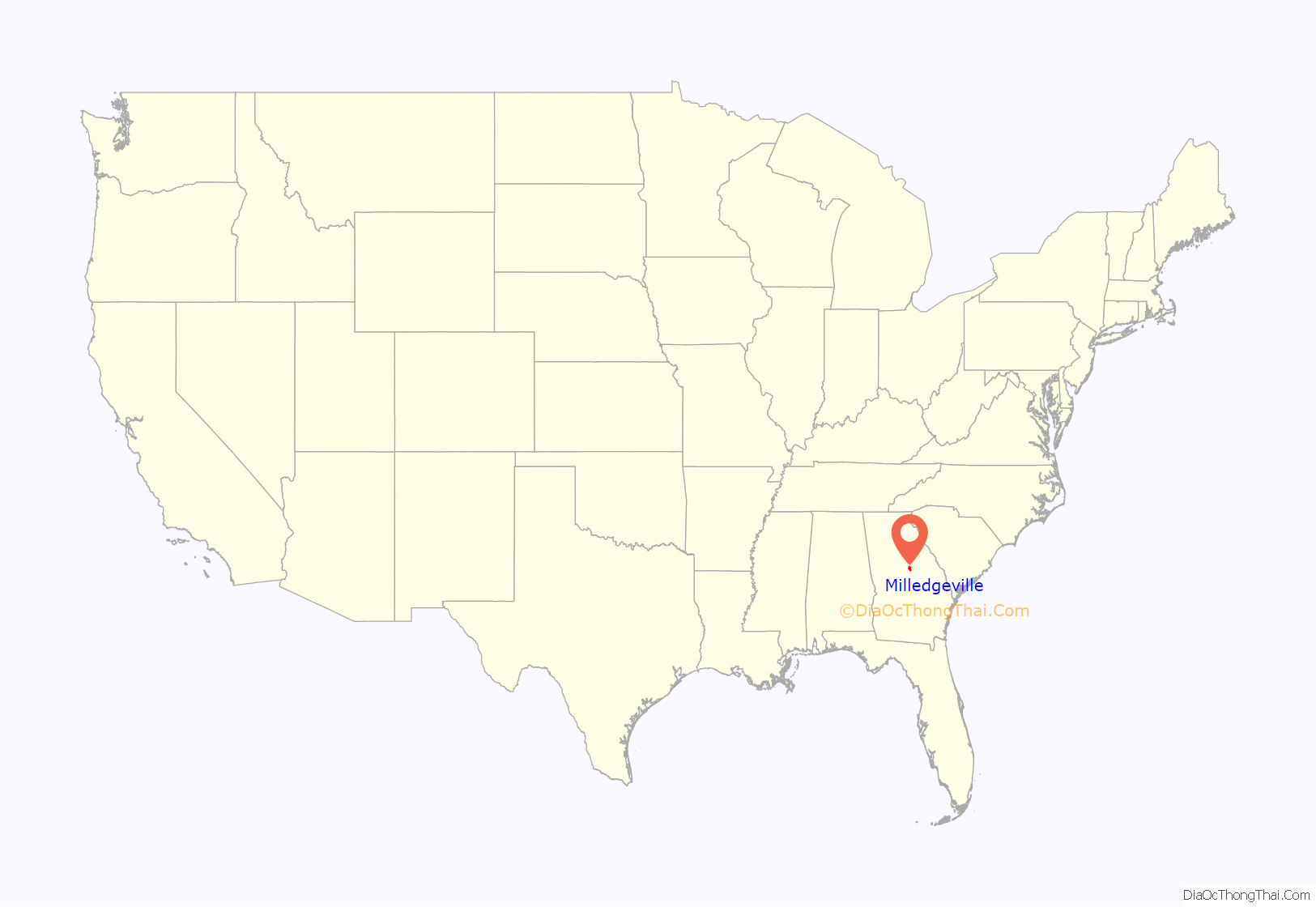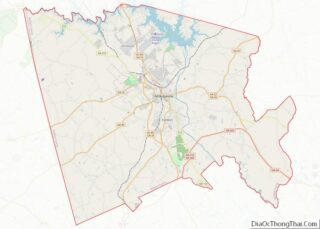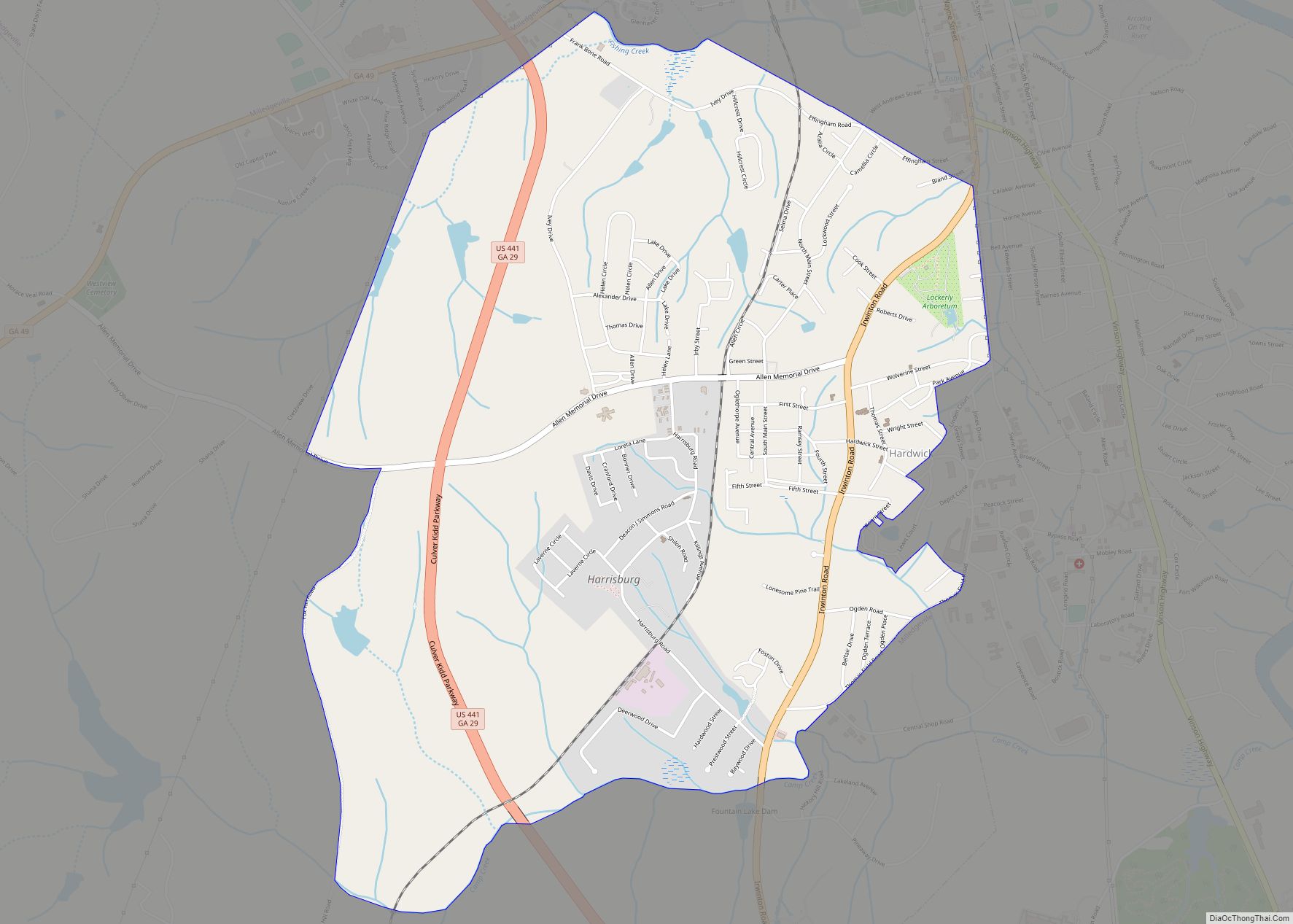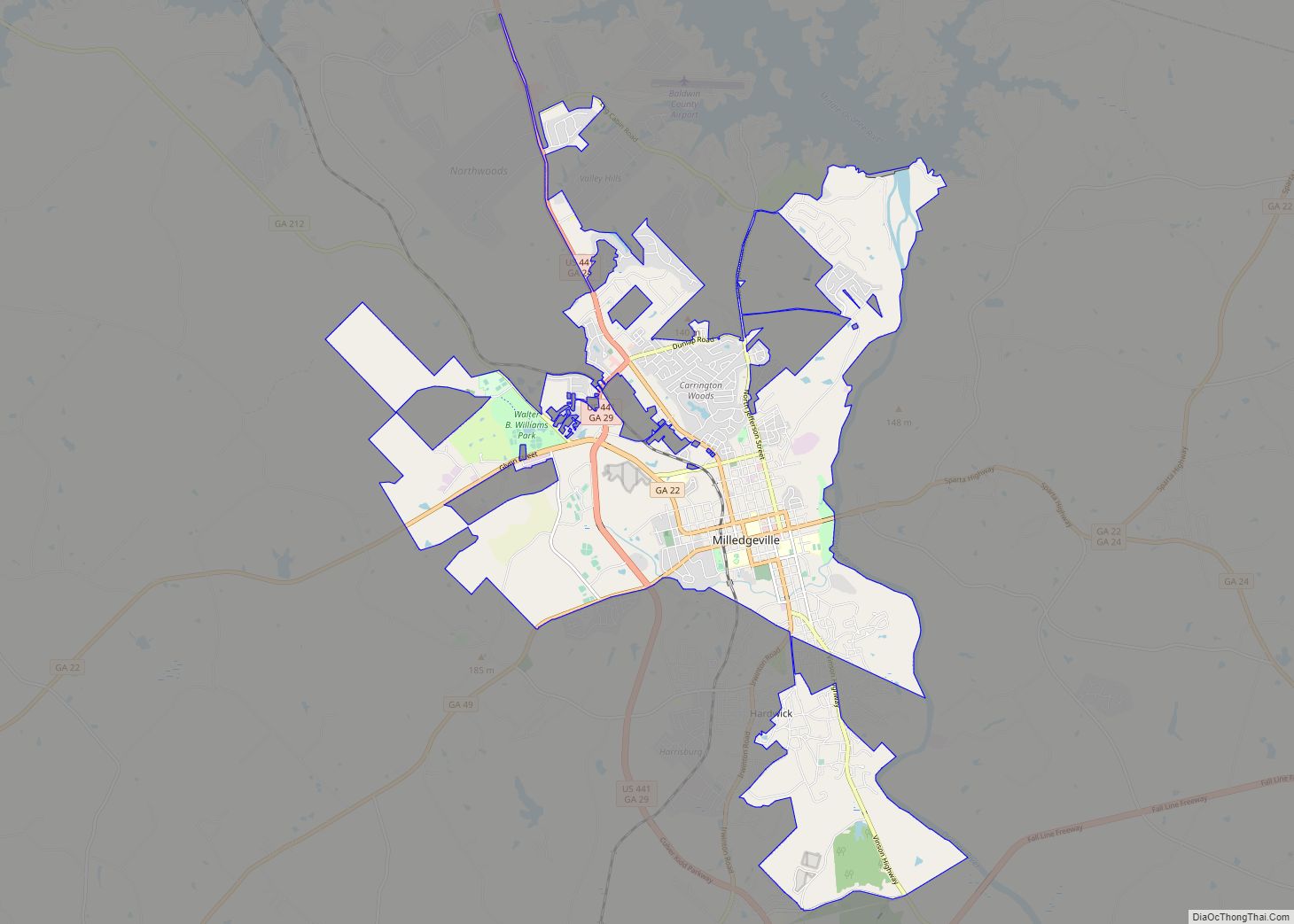Milledgeville is a city in and the county seat of Baldwin County in the U.S. state of Georgia. It is northeast of Macon and bordered on the east by the Oconee River. The rapid current of the river here made this an attractive location to build a city. It was the capital of Georgia from 1804 to 1868, including during the American Civil War. Milledgeville was preceded as the capital city by Louisville and was succeeded by Atlanta, the current capital. Today U.S. Highway 441 connects Milledgeville to Madison, Athens, and Dublin.
As of April 1, 2020, the population of Milledgeville was 17,070 down from 17,715 at the 2010 US Census.
Milledgeville is along the route of the Fall Line Freeway, which is under construction to link Milledgeville with Augusta, Macon, Columbus, and other Fall Line cities. They have long histories from the colonial era of Georgia.
Milledgeville is the principal city of the Milledgeville Micropolitan Statistical Area, a micropolitan area that includes Baldwin and Hancock counties. It had a combined population of 52,534 at the 2020 census. The Old State Capitol is located here; it was added to the National Register of Historic Places (NRHP). Much of the original city is contained within the boundaries of the Milledgeville Historic District, which was also added to the NRHP.
| Name: | Milledgeville city |
|---|---|
| LSAD Code: | 25 |
| LSAD Description: | city (suffix) |
| State: | Georgia |
| County: | Baldwin County |
| Incorporated: | December 12, 1804; 218 years ago (1804-12-12) |
| Elevation: | 330 ft (100 m) |
| Total Area: | 20.48 sq mi (53.05 km²) |
| Land Area: | 20.32 sq mi (52.63 km²) |
| Water Area: | 0.16 sq mi (0.42 km²) |
| Total Population: | 17,070 |
| Population Density: | 839.98/sq mi (324.31/km²) |
| Area code: | 478 |
| FIPS code: | 1351492 |
| GNISfeature ID: | 0332390 |
| Website: | milledgevillega.us |
Online Interactive Map
Click on ![]() to view map in "full screen" mode.
to view map in "full screen" mode.
Milledgeville location map. Where is Milledgeville city?
History
Milledgeville, named after Georgia governor John Milledge (in office 1802–1806), was founded by European Americans at the start of the 19th century as the new centrally located capital of the state of Georgia. It served as the state capital from 1804 to 1868.
In 1803 an act of the Georgia legislature called for the establishment and survey of a town to be named in honor of the current governor, John Milledge. The Treaty of Fort Wilkinson (1802) had recently forced Native American tribes to cede territory immediately west of the Oconee River. The white population of Georgia continued to press west and south in search of new farmland. The town of Milledgeville was developed in an area that had long been occupied by indigenous peoples.
In December 1804 the state legislature declared Milledgeville the new capital of Georgia. The new planned town, modeled after Savannah and Washington, D.C., stood on the edge of the frontier at the Atlantic fall line, where the Upper Coastal Plain meets the foothills and plateau of the Piedmont. The area was surveyed, and a town plat of 500 acres (2.0 km) was divided into 84 4-acre (16,000 m) squares. The survey also included four public squares of 20 acres (81,000 m) each.
Life in the antebellum capital
After 1815 Milledgeville became increasingly prosperous and more respectable. Wealth and power gravitated toward the capital. Much of the surrounding countryside was developed by slave labor for cotton plantations, which was the major commodity crop of the South. Cotton bales regularly were set up to line the roads, waiting to be shipped downriver to Darien.
Public-spirited citizens such as Tomlinson Fort (mayor of Milledgeville, 1847–1848) promoted better newspapers, learning academies, and banks. In 1837-1842 the Georgia Lunatic Asylum (later the Central State Hospital) was built here. Oglethorpe University, where the poet Sidney Lanier was later educated, opened its doors in 1838. (The college, forced to close in 1862 during the war, was rechartered in 1913. It moved its campus to Atlanta.)
The cotton boom in this upland area significantly increased the demand for slave labor. The town market, where slave auctions took place, was located on Capital Square, next to the Presbyterian church. Skilled black carpenters, masons, and laborers were forced to construct most of the handsome antebellum structures in Milledgeville.
Two events epitomized Milledgeville’s status as the political and social center of Georgia in this period:
- In 1825 the capital was visited by American Revolutionary War hero and aristocrat, the Marquis de Lafayette. The receptions, barbecue, formal dinner, and grand ball for the veteran apostle of liberty seemed to mark Milledgeville’s coming of age.
- The Governor’s Mansion was constructed (1836-38/39); it was one of the most important examples of Greek revival architecture in America.
By 1854 Baldwin County had a total population of 8,148, of whom 3,566 were free (mostly white), and 4,602 were African-American slaves.
American Civil War and its aftermath
On January 19, 1861, Georgia convention delegates passed the Ordinance of Secession, and on February 4, 1861, the “Republic of Georgia” joined the Confederate States of America. In November 1864 Union general William T. Sherman and 30,000 Union troops marched into Milledgeville during his March to the Sea. Before leaving a couple of days later, they poured sorghum and molasses down the pipes of the organ at St. Stephen’s Episcopal Church.
In 1868, during Reconstruction, the state legislature moved the capital to Atlanta—a city emerging as the symbol of the New South as surely as Milledgeville symbolized the Old South.
Milledgeville struggled to survive as a city after losing the business of the capital. The energetic efforts of local leaders established the Middle Georgia Military and Agricultural College (later Georgia Military College) in 1879 on Statehouse Square. Where the crumbling remains of the old penitentiary stood, Georgia Normal and Industrial College (later Georgia College & State University) was founded in 1889. In part because of these institutions, as well as Central State Hospital, Milledgeville developed as a less provincial town than many of its neighbors.
Twentieth century to present
In the 1950s the Georgia Power Company completed a dam at Furman Shoals on the Oconee River, about 5 miles (8 km) north of town, creating a huge reservoir called Lake Sinclair. The lake community became an increasingly important part of the town’s social and economic identity.
In the 1980s and 1990s Milledgeville began to capitalize on its heritage by revitalizing the downtown and historic district. It encouraged restoration of historic buildings and an urban design scheme on Main Street to emphasize its character.
By 2000 the population of Milledgeville and Baldwin County combined had grown to 44,700. Community leaders have made concerted efforts to create a more diversified economic base, striving to wean the old capital from its dependence on government institutions such as Central State Hospital and state prisons. The state has recently closed some prisons and reduced jobs at Central State, due to tightening state budgets.
Milledgeville Road Map
Milledgeville city Satellite Map
Geography
Milledgeville is located at 33°5′16″N 83°14′0″W / 33.08778°N 83.23333°W / 33.08778; -83.23333 (33.087755, -83.233401) and is 301 feet (92 m) above sea level.
According to the United States Census Bureau, the city has a total area of 20.6 square miles (53.3 km), of which 20.4 square miles (52.9 km) is land and 0.15 square miles (0.4 km), or 0.74%, is water.
U.S. Route 441 is the main route through the city, leading north 21 mi (34 km) to Eatonton and south 22 mi (35 km) to Irwinton. Georgia State Routes 22, 24, and 49 also run through the city as well. GA-22 leads northeast 24 mi (39 km) to Sparta and southwest 20 mi (32 km) to Gray. GA-24 leads east 29 mi (47 km) to Sandersville and north to Eatonton with U.S. 441. GA-49 leads southwest 30 mi (48 km) to Macon.
Milledgeville is located on the Atlantic Seaboard fall line of the United States. The Oconee River flows a half mile east of downtown on its way south to the Altamaha River and then south to the Atlantic Ocean. Lake Sinclair, a man-made lake, is about 5 miles (8 km) northeast of Milledgeville on the border of Baldwin, Putnam and Hancock counties.
Milledgeville is composed of two main districts: a heavily commercialized area along the highway known to locals simply as “441,” extending from a few blocks north of Georgia College & State University to 4 miles (6 km) north of Milledgeville, and the “Downtown” area, encompassing the college, buildings housing city government agencies, various bars and restaurants. This historic area was laid out in 1803, with streets named after other counties in Georgia.
Climate
See also
Map of Georgia State and its subdivision:- Appling
- Atkinson
- Bacon
- Baker
- Baldwin
- Banks
- Barrow
- Bartow
- Ben Hill
- Berrien
- Bibb
- Bleckley
- Brantley
- Brooks
- Bryan
- Bulloch
- Burke
- Butts
- Calhoun
- Camden
- Candler
- Carroll
- Catoosa
- Charlton
- Chatham
- Chattahoochee
- Chattooga
- Cherokee
- Clarke
- Clay
- Clayton
- Clinch
- Cobb
- Coffee
- Colquitt
- Columbia
- Cook
- Coweta
- Crawford
- Crisp
- Dade
- Dawson
- Decatur
- DeKalb
- Dodge
- Dooly
- Dougherty
- Douglas
- Early
- Echols
- Effingham
- Elbert
- Emanuel
- Evans
- Fannin
- Fayette
- Floyd
- Forsyth
- Franklin
- Fulton
- Gilmer
- Glascock
- Glynn
- Gordon
- Grady
- Greene
- Gwinnett
- Habersham
- Hall
- Hancock
- Haralson
- Harris
- Hart
- Heard
- Henry
- Houston
- Irwin
- Jackson
- Jasper
- Jeff Davis
- Jefferson
- Jenkins
- Johnson
- Jones
- Lamar
- Lanier
- Laurens
- Lee
- Liberty
- Lincoln
- Long
- Lowndes
- Lumpkin
- Macon
- Madison
- Marion
- McDuffie
- McIntosh
- Meriwether
- Miller
- Mitchell
- Monroe
- Montgomery
- Morgan
- Murray
- Muscogee
- Newton
- Oconee
- Oglethorpe
- Paulding
- Peach
- Pickens
- Pierce
- Pike
- Polk
- Pulaski
- Putnam
- Quitman
- Rabun
- Randolph
- Richmond
- Rockdale
- Schley
- Screven
- Seminole
- Spalding
- Stephens
- Stewart
- Sumter
- Talbot
- Taliaferro
- Tattnall
- Taylor
- Telfair
- Terrell
- Thomas
- Tift
- Toombs
- Towns
- Treutlen
- Troup
- Turner
- Twiggs
- Union
- Upson
- Walker
- Walton
- Ware
- Warren
- Washington
- Wayne
- Webster
- Wheeler
- White
- Whitfield
- Wilcox
- Wilkes
- Wilkinson
- Worth
- Alabama
- Alaska
- Arizona
- Arkansas
- California
- Colorado
- Connecticut
- Delaware
- District of Columbia
- Florida
- Georgia
- Hawaii
- Idaho
- Illinois
- Indiana
- Iowa
- Kansas
- Kentucky
- Louisiana
- Maine
- Maryland
- Massachusetts
- Michigan
- Minnesota
- Mississippi
- Missouri
- Montana
- Nebraska
- Nevada
- New Hampshire
- New Jersey
- New Mexico
- New York
- North Carolina
- North Dakota
- Ohio
- Oklahoma
- Oregon
- Pennsylvania
- Rhode Island
- South Carolina
- South Dakota
- Tennessee
- Texas
- Utah
- Vermont
- Virginia
- Washington
- West Virginia
- Wisconsin
- Wyoming






